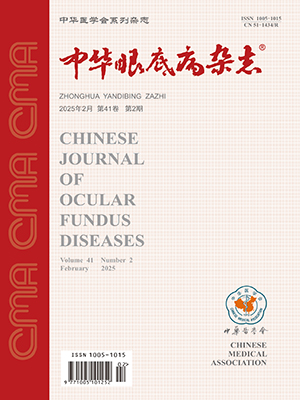| 1. |
Shimada N, Ohno-MatsuiK, Nishimuta A, et al. Detection of paravascular lamellar holes and other paravascular abnormalities by optical coherence tomography in eyes with high myopia[J]. Ophthalmology, 2008, 115(4): 708-717. DOI: 10.1016/j.ophtha.2007.04.060.
|
| 2. |
Liu HY, Hsieh YT, Yang CM. Paravascular abnormalities in eyes with idiopathic epiretinal membrane[J]. Graefe's Arch Clin Exp Ophthalmol, 2016, 254(9): 1723-1729. DOI: 10.1007/s00417-016-3276-3.
|
| 3. |
Faghihi H, Hajizadeh F, Riazi-Esfahani M. Optical coherence tomographic findings in highly myopic eyes[J]. J Ophthalmic Vis Res, 2010, 5: 110-121.
|
| 4. |
Ohno-Matsui K, Hayashi K, Tokoro T, et al. Detection of paravascular retinal cysts before using OCT in a highly myopic patient[J]. Graefe's Arch Clin Exp Ophthalmol, 2006, 244(5): 642-644. DOI: 10.1007/s00417-005-0112-6.
|
| 5. |
Sayanagi K, Ikuno Y, Gomi F, et al. Retinal vascular microfolds in highly myopic eyes[J]. Am J Ophthalmol, 2005, 139: 658-663. DOI: 10.1016/j.ajo.2004.11.025.
|
| 6. |
Sayanagi K, Morimoto Y, Ikuno Y, et al. Spectral-domin optical coherence tomographic findins in myopic foveoschisis[J]. Retina, 2010, 30(4): 623-628. DOI: 10.1097/iae.0b013e3181ca4e7c.
|
| 7. |
Osaka R, Manabe S, Miyoshi Y, et al. Paravascular inner retinal abnormalities in healthy eyes[J]. Graefe's Arch Clin Exp Ophthalmol, 2017, 255(9): 1743-1748. DOI: 10.1007/s00417-017-3717-7.
|
| 8. |
Flitcroft DI, He M, Jonas JB, et al. IMI-defining and classifying myopia: a proposed set of standards for clinical and epidemiologic studies[J]. Invest Ophthalmol Vis Sci, 2019, 60(3): M20-M30. DOI: 10.1167/iovs.18-25957.
|
| 9. |
Grzybowski A, Kanclerz P. The standardized definition of high myopia[J/OL]. Graefe's Arch Clin Exp Ophthalmol, 2019, 257(8): 1805[2019-06-21]. https://pubmed.ncbi.nlm.nih.gov/31222407/. DOI: 10.1007/s00417-019-04397-w.
|
| 10. |
Cumberland PM, Bountziouka V, Rahi JS. Impact of varying the definition of myopia on estimates of prevalence and associations with risk factors: time for an approach that serves research, practice and policy[J]. Br J Ophthalmol, 2018, 102(10): 1407-1412. DOI: 10.1136/bjophthalmol-2017-311557.
|
| 11. |
Li T, Wang X, Zhou Y, et al. Paravascular abnormalities observed by spectral domain optical coherence tomography are risk factors for retinoschisis in eyes with high myopia[J/OL]. Acta Ophthalmologica, 2017, 96(4): e515-e523[2017-11-24]. https://pubmed.ncbi.nlm.nih.gov/29171725/. DOI: 10.1111/aos.13628.
|
| 12. |
Kamal-Salah R, Morillo-Sanchez MJ, Rius-Diaz F, et al. Relationship between paravascular abnormalities and foveoschisis in highly myopic patients[J]. Eye (Lond), 2015, 29(2): 280-285. DOI: 10.1038/eye.2014.255.
|
| 13. |
Shimada N, Ohno-Matsui K, Nishimuta A, et al. Peripapillary changes detected by optical coherence tomography in eyes with high myopia[J]. Ophthalmology, 2007, 114: 2070-2076. DOI: 10.1016/j.ophtha.2007.01.016.
|
| 14. |
Henaine-Berra A, Zand-Hadas IM, Fromow-Guerra J, et al. Prevalence of macular anatomic abnormalities in high myopia[J]. Ophthalmic Surg Lasers Imaging Retina, 2013, 44(2): 140-144. DOI: 10.3928/23258160-20130219-01.
|
| 15. |
Xiao W, Zhu Z, Odouard C, et al. Wide-field en face swept-source optical coherence tomography features of extrafoveal retinoschisis in highly myopic eyes[J]. Invest Ophthalmol Vis Sci, 2017, 58(2): 1037-1044. DOI: 10.1167/iovs.16-20607.
|
| 16. |
Vela JI, Sánchez F, Díaz-Cascajosa J, et al. Incidence and distribution of paravascular lamellar holes and their relationship with macular retinoschisis in highly myopic eyes using spectral-domain OCT[J]. Int Ophthalmol, 2016, 36(2): 247-252. DOI: 10.1007/s10792-015-0110-6.
|
| 17. |
Panozzo G, Mercanti A. Optical coherence tomography findings in myopic traction maculopathy[J]. Arch Ophthalmol, 2004, 122(10): 1455-1460. DOI: 10.1001/archopht.122.10.1455.
|
| 18. |
Wu PC, Chen YJ, Chen YH, et al. Factors associated with foveoschisis and foveal detachment without macular hole in high myopia[J]. Eye (Lond), 2009, 23(2): 356-361. DOI: 10.1038/sj.eye.6703038.
|
| 19. |
Muraoka Y, Tsujikawa A, Hata M, et al. Paravascular inner retinal defect associated with high myopia or epiretinal membrane[J]. JAMA Ophthalmol, 2015, 133(4): 413-420. DOI: 10.1001/jamaophthalmol.2014.5632.
|
| 20. |
Curtin BJ. The posterior staphyloma of pathologic myopia[J]. Trans Am Ophthalmol, 1977, 75: 67-86.
|
| 21. |
Ohno-Matsui K. Proposed classification of posterior staphylomas based on analyses of eye shape by three-dimensional magnetic resonance imaging and wide-field fundus imaging[J]. Ophthalmology, 2014, 121(9): 1798-1809. DOI: 10.1016/j.ophtha.2014.03.035.
|




